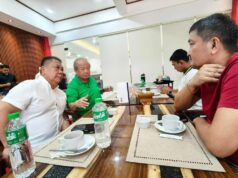The poor are back in our consciousness. Newspapers, radios, television, leaflets and brochures triumph them. Name the medium, they’re there. They are hugged with the warmth of the sunrise, like they are the long lost mothers, fathers, brothers and sisters. They are respected with the seriousness close to a religion. They are heard like their voices are jewels from deep seas. Warm handshakes are accorded to them, like they are dignitaries from distant lands. Their presence is sought for, especially for photo-ops. They are asked to sing the promises of a bright future. They look hopeful. They are not starved. Some even brag that they came from their ranks.
We know it. It is election time again. We have seen these images. They are not sweet dreams freshly woven by new conjurers. Yes, Gerard, these images come every election time.
However, expect things to go back as normal. What is normal? The poor are excluded from the life-sustaining circuits of national life. They march to the streets as lolos and lolas, appealing to a heartless government to cut the e-vat of their expensive medicines. Their children do not finish elementary education, not because they are drug-sniffing nitwits, but because they do not have the necessary pencils, notebooks and books. In fact, they can not only buy books, they also do not have the means to fill in their empty stomachs.
One in every ten Filipinos lives with a $1 a day, according to a UN statistics. Another 42 percent or so of the 80 million Filipinos live with barely $2. There is food, but this does not reach them. Their food is snatched into the dining tables in New York by insatiable gluttons called Philippine public officials.
Their once fertile soil, upon which they plant their food, crack due to the heat of the environment. For generations, they do not own their lands. Like flies, they are forever caught in the web of usurious borrowings. If and when they protest, they are truncheoned with impunity, abducted in broad daylight and/or live in constant fear of another massacre that escalates by day. In perennial desperation, they sell their bodies, either as a whole for sex-starved vultures, or as parts, cut into pieces (heart, kidney, eyes, etc.) to be auctioned in the black market. When they get sick, they die without even seeing a doctor. They build their shanties on river banks, under or beside public bridges, or in nearby drainage canals.
When you “see” these images, you know, it’s not election time. It’s real time. These images are not the sweet dreams peddled on infomercials. They are the nightmares that are real. They come with drug-crazed children knocking at cars of the rich. They also show jam-packed classrooms of 60 students each. If you look closer, these images show that the kids do not have decent shoes.
In the meantime, the people who promise to resurrect them are growing richer by the day. Malou Mangahas of the Philippine Center for Investigative Journalism (PCIJ) affirms this in her report titled “Top bets for president grew wealth despite poll expenses.”
Two days ago, Cristy, a young woman studying in a nearby public high school where I teach, cut my busy walk. She showed me a 25 centavo coin, and asked: Kuya, pwedeng makahingi ng 75, pambili ko lang ng tinapay? I knew that this is the face of the poor that the political advertisements do not speak.
If you want to clear your jaded eyes from the “poor” images circling around, go and watch Bunso. This is a documentary on children in Philippine prisons made by Ditsi Carolino. In Bunso, you meet Tony (13), Dionel (11) and Bunso (11) himself. They will chorus to you, along with other children, how poverty cuts the very oxygen they breathe. All three children died in the city streets, but more precisely, they run out of life because of neglect.
If you are not into documentaries, go and feast your eyes on Joey Velasco’s paintings. The paintings are called Hapag ng Pag-asa. In the internet, you can download the videos of Mr. Velasco. There, you will meet Jomar (14) and his friends. They will sing to you what poverty really means.
Then, you will know what these politicians are hiding from us. To be poor is absolutely not cool.
tobe_wtdpoor@yahoo.com
We know it. It is election time again. We have seen these images. They are not sweet dreams freshly woven by new conjurers. Yes, Gerard, these images come every election time.
However, expect things to go back as normal. What is normal? The poor are excluded from the life-sustaining circuits of national life. They march to the streets as lolos and lolas, appealing to a heartless government to cut the e-vat of their expensive medicines. Their children do not finish elementary education, not because they are drug-sniffing nitwits, but because they do not have the necessary pencils, notebooks and books. In fact, they can not only buy books, they also do not have the means to fill in their empty stomachs.
One in every ten Filipinos lives with a $1 a day, according to a UN statistics. Another 42 percent or so of the 80 million Filipinos live with barely $2. There is food, but this does not reach them. Their food is snatched into the dining tables in New York by insatiable gluttons called Philippine public officials.
Their once fertile soil, upon which they plant their food, crack due to the heat of the environment. For generations, they do not own their lands. Like flies, they are forever caught in the web of usurious borrowings. If and when they protest, they are truncheoned with impunity, abducted in broad daylight and/or live in constant fear of another massacre that escalates by day. In perennial desperation, they sell their bodies, either as a whole for sex-starved vultures, or as parts, cut into pieces (heart, kidney, eyes, etc.) to be auctioned in the black market. When they get sick, they die without even seeing a doctor. They build their shanties on river banks, under or beside public bridges, or in nearby drainage canals.
When you “see” these images, you know, it’s not election time. It’s real time. These images are not the sweet dreams peddled on infomercials. They are the nightmares that are real. They come with drug-crazed children knocking at cars of the rich. They also show jam-packed classrooms of 60 students each. If you look closer, these images show that the kids do not have decent shoes.
In the meantime, the people who promise to resurrect them are growing richer by the day. Malou Mangahas of the Philippine Center for Investigative Journalism (PCIJ) affirms this in her report titled “Top bets for president grew wealth despite poll expenses.”
Two days ago, Cristy, a young woman studying in a nearby public high school where I teach, cut my busy walk. She showed me a 25 centavo coin, and asked: Kuya, pwedeng makahingi ng 75, pambili ko lang ng tinapay? I knew that this is the face of the poor that the political advertisements do not speak.
If you want to clear your jaded eyes from the “poor” images circling around, go and watch Bunso. This is a documentary on children in Philippine prisons made by Ditsi Carolino. In Bunso, you meet Tony (13), Dionel (11) and Bunso (11) himself. They will chorus to you, along with other children, how poverty cuts the very oxygen they breathe. All three children died in the city streets, but more precisely, they run out of life because of neglect.
If you are not into documentaries, go and feast your eyes on Joey Velasco’s paintings. The paintings are called Hapag ng Pag-asa. In the internet, you can download the videos of Mr. Velasco. There, you will meet Jomar (14) and his friends. They will sing to you what poverty really means.
Then, you will know what these politicians are hiding from us. To be poor is absolutely not cool.
tobe_wtdpoor@yahoo.com




